CNA252 Professional Practice 1: Simulated Clinical Activity Care Plan
VerifiedAdded on 2022/09/06
|8
|2588
|17
Homework Assignment
AI Summary
This assignment presents a detailed care plan developed using the clinical reasoning cycle, focusing on a patient named Carol Jones who presents with breathlessness, nausea, chest pain, and vital sign abnormalities. The assignment begins with collecting cues from the patient's history and current presentation, including her lifestyle, and interpreting the data to identify normal and abnormal findings. The student relates and infers the collected data to form an overall opinion, predicting potential outcomes if no action is taken. The core of the assignment involves identifying priority nursing problems, establishing a goal related to alcohol consumption, and outlining four specific nursing actions to achieve that goal, including 12-lead ECG and interpretation. Each action is supported by a rationale, linking pathophysiological and psychological principles. The assignment then describes how to evaluate the effectiveness of the care provided. Finally, the student reflects on the chosen skill (ECG) and discusses strengths, weaknesses, and actions to improve performance based on the Registered Nurse Standards for Practice. The clinical reasoning cycle's impact on the student's professional responsibility and future learning is also addressed.
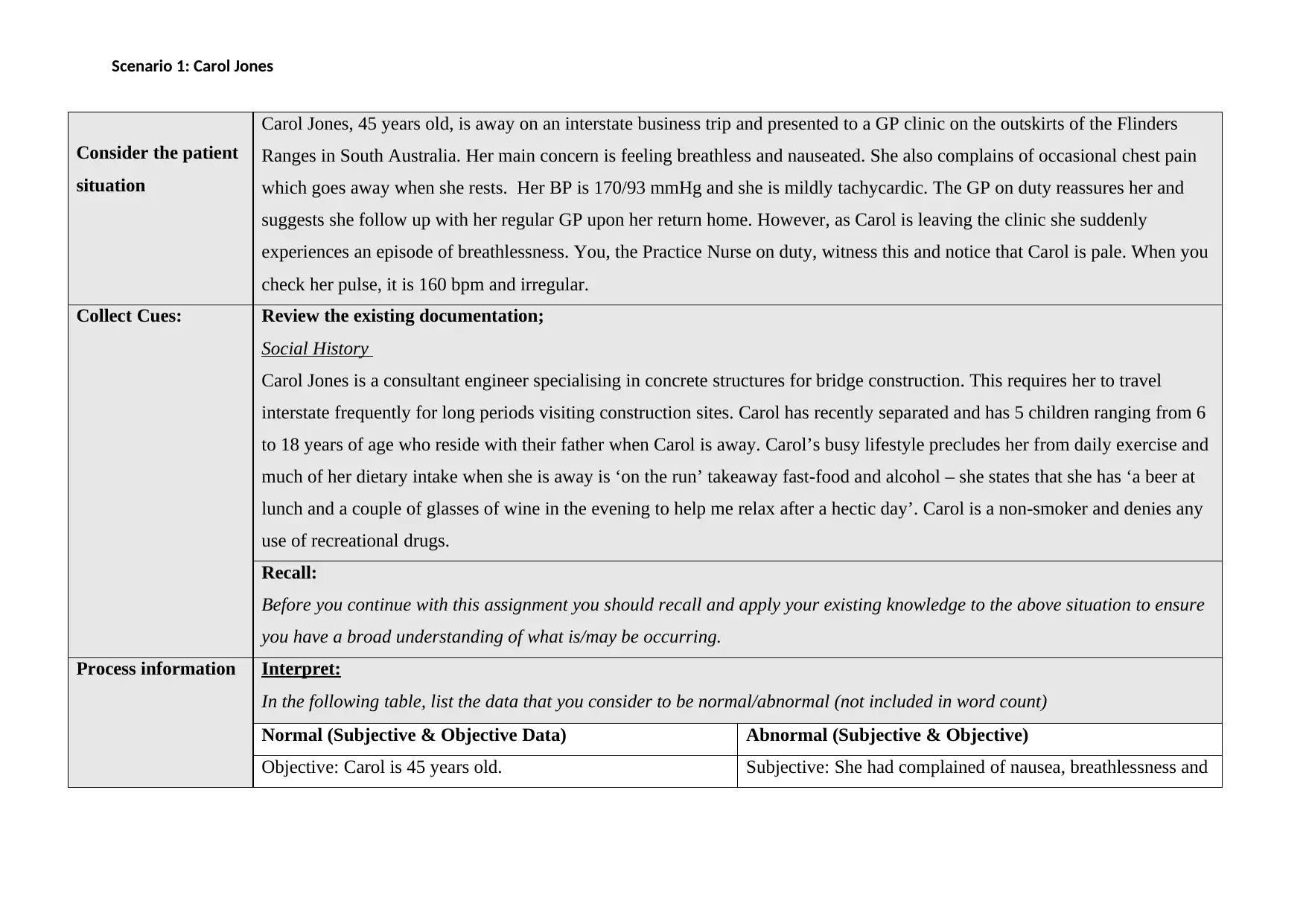
Scenario 1: Carol Jones
Consider the patient
situation
Carol Jones, 45 years old, is away on an interstate business trip and presented to a GP clinic on the outskirts of the Flinders
Ranges in South Australia. Her main concern is feeling breathless and nauseated. She also complains of occasional chest pain
which goes away when she rests. Her BP is 170/93 mmHg and she is mildly tachycardic. The GP on duty reassures her and
suggests she follow up with her regular GP upon her return home. However, as Carol is leaving the clinic she suddenly
experiences an episode of breathlessness. You, the Practice Nurse on duty, witness this and notice that Carol is pale. When you
check her pulse, it is 160 bpm and irregular.
Collect Cues: Review the existing documentation;
Social History
Carol Jones is a consultant engineer specialising in concrete structures for bridge construction. This requires her to travel
interstate frequently for long periods visiting construction sites. Carol has recently separated and has 5 children ranging from 6
to 18 years of age who reside with their father when Carol is away. Carol’s busy lifestyle precludes her from daily exercise and
much of her dietary intake when she is away is ‘on the run’ takeaway fast-food and alcohol – she states that she has ‘a beer at
lunch and a couple of glasses of wine in the evening to help me relax after a hectic day’. Carol is a non-smoker and denies any
use of recreational drugs.
Recall:
Before you continue with this assignment you should recall and apply your existing knowledge to the above situation to ensure
you have a broad understanding of what is/may be occurring.
Process information Interpret:
In the following table, list the data that you consider to be normal/abnormal (not included in word count)
Normal (Subjective & Objective Data) Abnormal (Subjective & Objective)
Objective: Carol is 45 years old. Subjective: She had complained of nausea, breathlessness and
Consider the patient
situation
Carol Jones, 45 years old, is away on an interstate business trip and presented to a GP clinic on the outskirts of the Flinders
Ranges in South Australia. Her main concern is feeling breathless and nauseated. She also complains of occasional chest pain
which goes away when she rests. Her BP is 170/93 mmHg and she is mildly tachycardic. The GP on duty reassures her and
suggests she follow up with her regular GP upon her return home. However, as Carol is leaving the clinic she suddenly
experiences an episode of breathlessness. You, the Practice Nurse on duty, witness this and notice that Carol is pale. When you
check her pulse, it is 160 bpm and irregular.
Collect Cues: Review the existing documentation;
Social History
Carol Jones is a consultant engineer specialising in concrete structures for bridge construction. This requires her to travel
interstate frequently for long periods visiting construction sites. Carol has recently separated and has 5 children ranging from 6
to 18 years of age who reside with their father when Carol is away. Carol’s busy lifestyle precludes her from daily exercise and
much of her dietary intake when she is away is ‘on the run’ takeaway fast-food and alcohol – she states that she has ‘a beer at
lunch and a couple of glasses of wine in the evening to help me relax after a hectic day’. Carol is a non-smoker and denies any
use of recreational drugs.
Recall:
Before you continue with this assignment you should recall and apply your existing knowledge to the above situation to ensure
you have a broad understanding of what is/may be occurring.
Process information Interpret:
In the following table, list the data that you consider to be normal/abnormal (not included in word count)
Normal (Subjective & Objective Data) Abnormal (Subjective & Objective)
Objective: Carol is 45 years old. Subjective: She had complained of nausea, breathlessness and
Paraphrase This Document
Need a fresh take? Get an instant paraphrase of this document with our AI Paraphraser
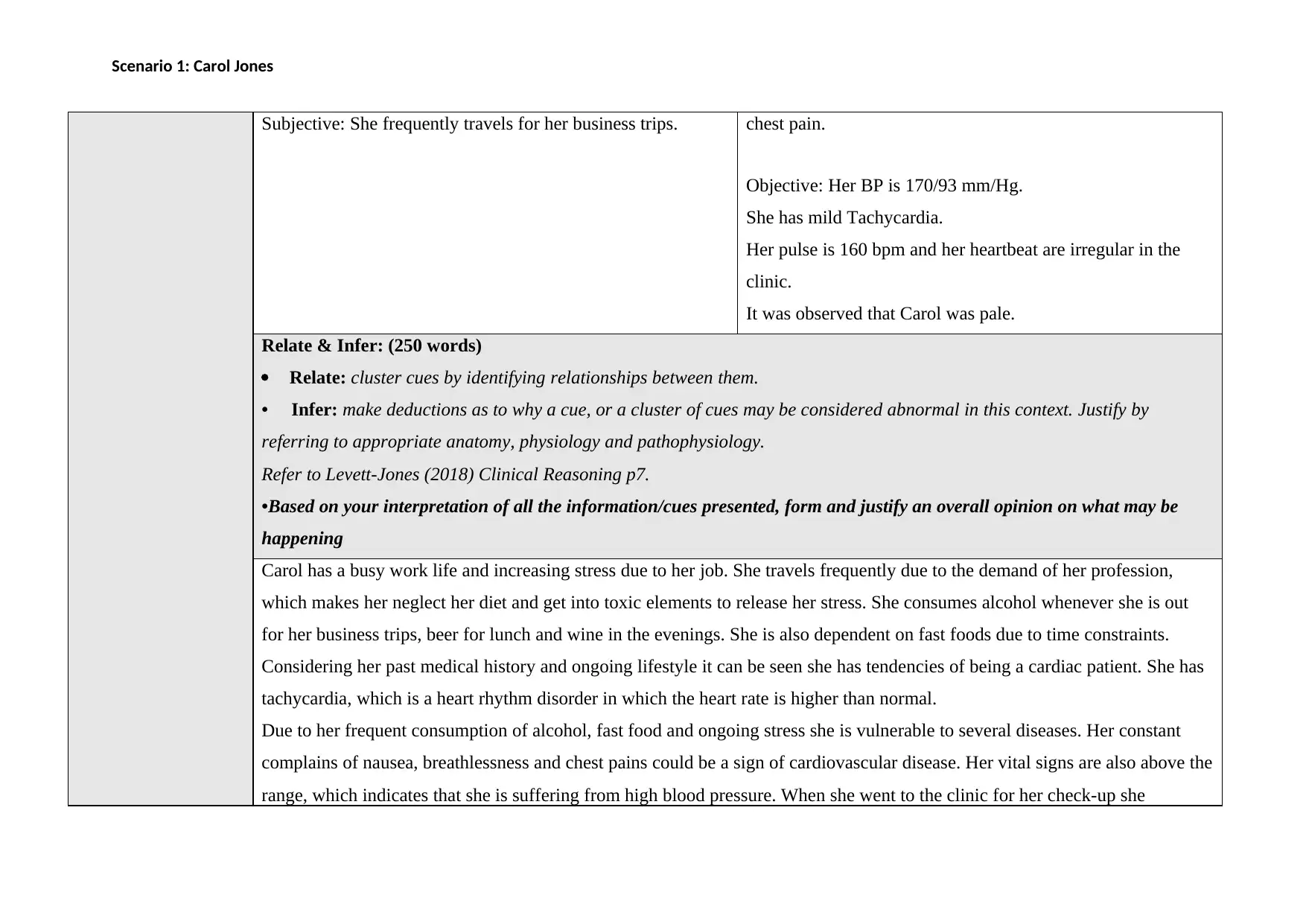
Scenario 1: Carol Jones
Subjective: She frequently travels for her business trips. chest pain.
Objective: Her BP is 170/93 mm/Hg.
She has mild Tachycardia.
Her pulse is 160 bpm and her heartbeat are irregular in the
clinic.
It was observed that Carol was pale.
Relate & Infer: (250 words)
Relate: cluster cues by identifying relationships between them.
• Infer: make deductions as to why a cue, or a cluster of cues may be considered abnormal in this context. Justify by
referring to appropriate anatomy, physiology and pathophysiology.
Refer to Levett-Jones (2018) Clinical Reasoning p7.
•Based on your interpretation of all the information/cues presented, form and justify an overall opinion on what may be
happening
Carol has a busy work life and increasing stress due to her job. She travels frequently due to the demand of her profession,
which makes her neglect her diet and get into toxic elements to release her stress. She consumes alcohol whenever she is out
for her business trips, beer for lunch and wine in the evenings. She is also dependent on fast foods due to time constraints.
Considering her past medical history and ongoing lifestyle it can be seen she has tendencies of being a cardiac patient. She has
tachycardia, which is a heart rhythm disorder in which the heart rate is higher than normal.
Due to her frequent consumption of alcohol, fast food and ongoing stress she is vulnerable to several diseases. Her constant
complains of nausea, breathlessness and chest pains could be a sign of cardiovascular disease. Her vital signs are also above the
range, which indicates that she is suffering from high blood pressure. When she went to the clinic for her check-up she
Subjective: She frequently travels for her business trips. chest pain.
Objective: Her BP is 170/93 mm/Hg.
She has mild Tachycardia.
Her pulse is 160 bpm and her heartbeat are irregular in the
clinic.
It was observed that Carol was pale.
Relate & Infer: (250 words)
Relate: cluster cues by identifying relationships between them.
• Infer: make deductions as to why a cue, or a cluster of cues may be considered abnormal in this context. Justify by
referring to appropriate anatomy, physiology and pathophysiology.
Refer to Levett-Jones (2018) Clinical Reasoning p7.
•Based on your interpretation of all the information/cues presented, form and justify an overall opinion on what may be
happening
Carol has a busy work life and increasing stress due to her job. She travels frequently due to the demand of her profession,
which makes her neglect her diet and get into toxic elements to release her stress. She consumes alcohol whenever she is out
for her business trips, beer for lunch and wine in the evenings. She is also dependent on fast foods due to time constraints.
Considering her past medical history and ongoing lifestyle it can be seen she has tendencies of being a cardiac patient. She has
tachycardia, which is a heart rhythm disorder in which the heart rate is higher than normal.
Due to her frequent consumption of alcohol, fast food and ongoing stress she is vulnerable to several diseases. Her constant
complains of nausea, breathlessness and chest pains could be a sign of cardiovascular disease. Her vital signs are also above the
range, which indicates that she is suffering from high blood pressure. When she went to the clinic for her check-up she
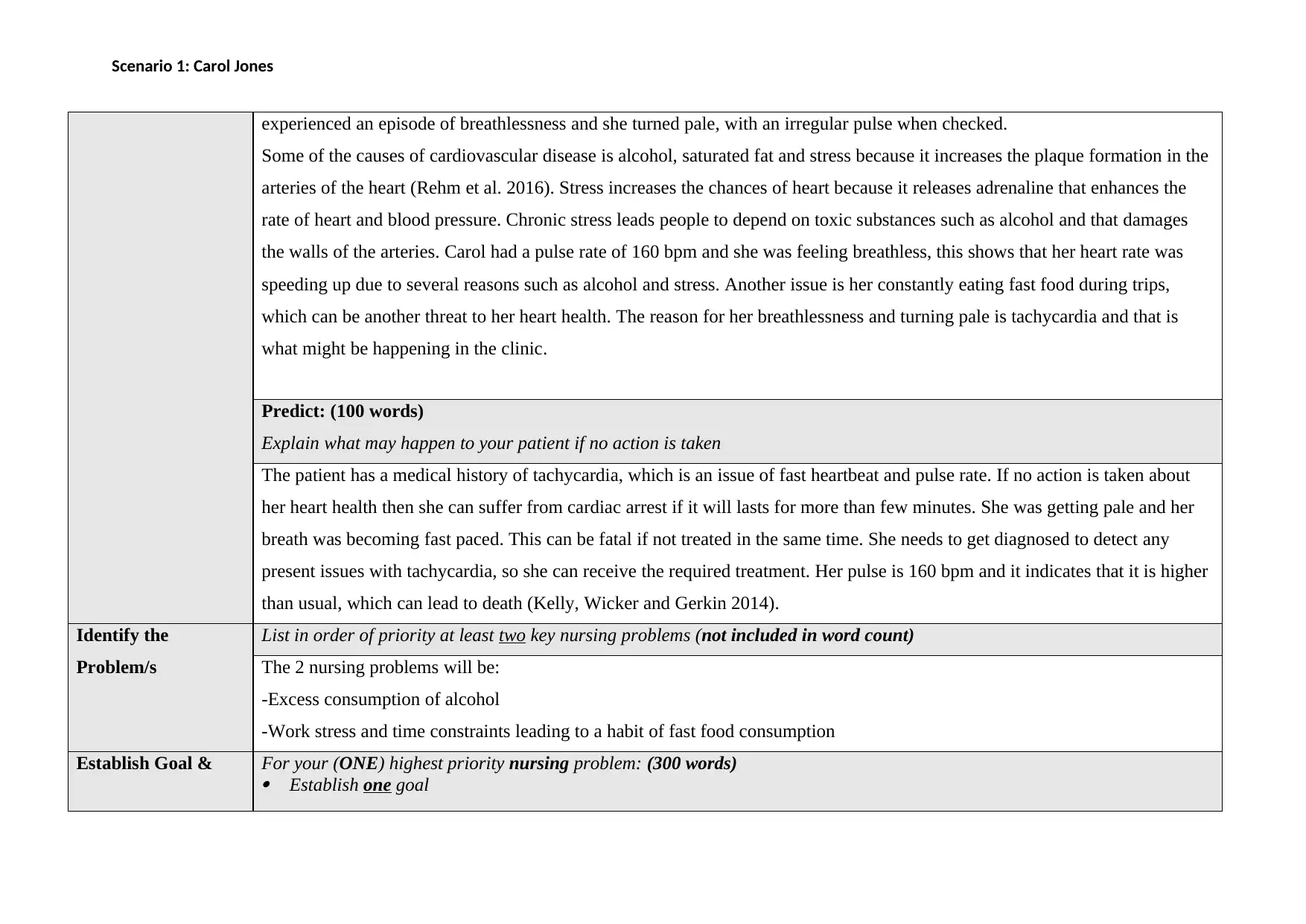
Scenario 1: Carol Jones
experienced an episode of breathlessness and she turned pale, with an irregular pulse when checked.
Some of the causes of cardiovascular disease is alcohol, saturated fat and stress because it increases the plaque formation in the
arteries of the heart (Rehm et al. 2016). Stress increases the chances of heart because it releases adrenaline that enhances the
rate of heart and blood pressure. Chronic stress leads people to depend on toxic substances such as alcohol and that damages
the walls of the arteries. Carol had a pulse rate of 160 bpm and she was feeling breathless, this shows that her heart rate was
speeding up due to several reasons such as alcohol and stress. Another issue is her constantly eating fast food during trips,
which can be another threat to her heart health. The reason for her breathlessness and turning pale is tachycardia and that is
what might be happening in the clinic.
Predict: (100 words)
Explain what may happen to your patient if no action is taken
The patient has a medical history of tachycardia, which is an issue of fast heartbeat and pulse rate. If no action is taken about
her heart health then she can suffer from cardiac arrest if it will lasts for more than few minutes. She was getting pale and her
breath was becoming fast paced. This can be fatal if not treated in the same time. She needs to get diagnosed to detect any
present issues with tachycardia, so she can receive the required treatment. Her pulse is 160 bpm and it indicates that it is higher
than usual, which can lead to death (Kelly, Wicker and Gerkin 2014).
Identify the
Problem/s
List in order of priority at least two key nursing problems (not included in word count)
The 2 nursing problems will be:
-Excess consumption of alcohol
-Work stress and time constraints leading to a habit of fast food consumption
Establish Goal & For your (ONE) highest priority nursing problem: (300 words)
Establish one goal
experienced an episode of breathlessness and she turned pale, with an irregular pulse when checked.
Some of the causes of cardiovascular disease is alcohol, saturated fat and stress because it increases the plaque formation in the
arteries of the heart (Rehm et al. 2016). Stress increases the chances of heart because it releases adrenaline that enhances the
rate of heart and blood pressure. Chronic stress leads people to depend on toxic substances such as alcohol and that damages
the walls of the arteries. Carol had a pulse rate of 160 bpm and she was feeling breathless, this shows that her heart rate was
speeding up due to several reasons such as alcohol and stress. Another issue is her constantly eating fast food during trips,
which can be another threat to her heart health. The reason for her breathlessness and turning pale is tachycardia and that is
what might be happening in the clinic.
Predict: (100 words)
Explain what may happen to your patient if no action is taken
The patient has a medical history of tachycardia, which is an issue of fast heartbeat and pulse rate. If no action is taken about
her heart health then she can suffer from cardiac arrest if it will lasts for more than few minutes. She was getting pale and her
breath was becoming fast paced. This can be fatal if not treated in the same time. She needs to get diagnosed to detect any
present issues with tachycardia, so she can receive the required treatment. Her pulse is 160 bpm and it indicates that it is higher
than usual, which can lead to death (Kelly, Wicker and Gerkin 2014).
Identify the
Problem/s
List in order of priority at least two key nursing problems (not included in word count)
The 2 nursing problems will be:
-Excess consumption of alcohol
-Work stress and time constraints leading to a habit of fast food consumption
Establish Goal & For your (ONE) highest priority nursing problem: (300 words)
Establish one goal
⊘ This is a preview!⊘
Do you want full access?
Subscribe today to unlock all pages.

Trusted by 1+ million students worldwide
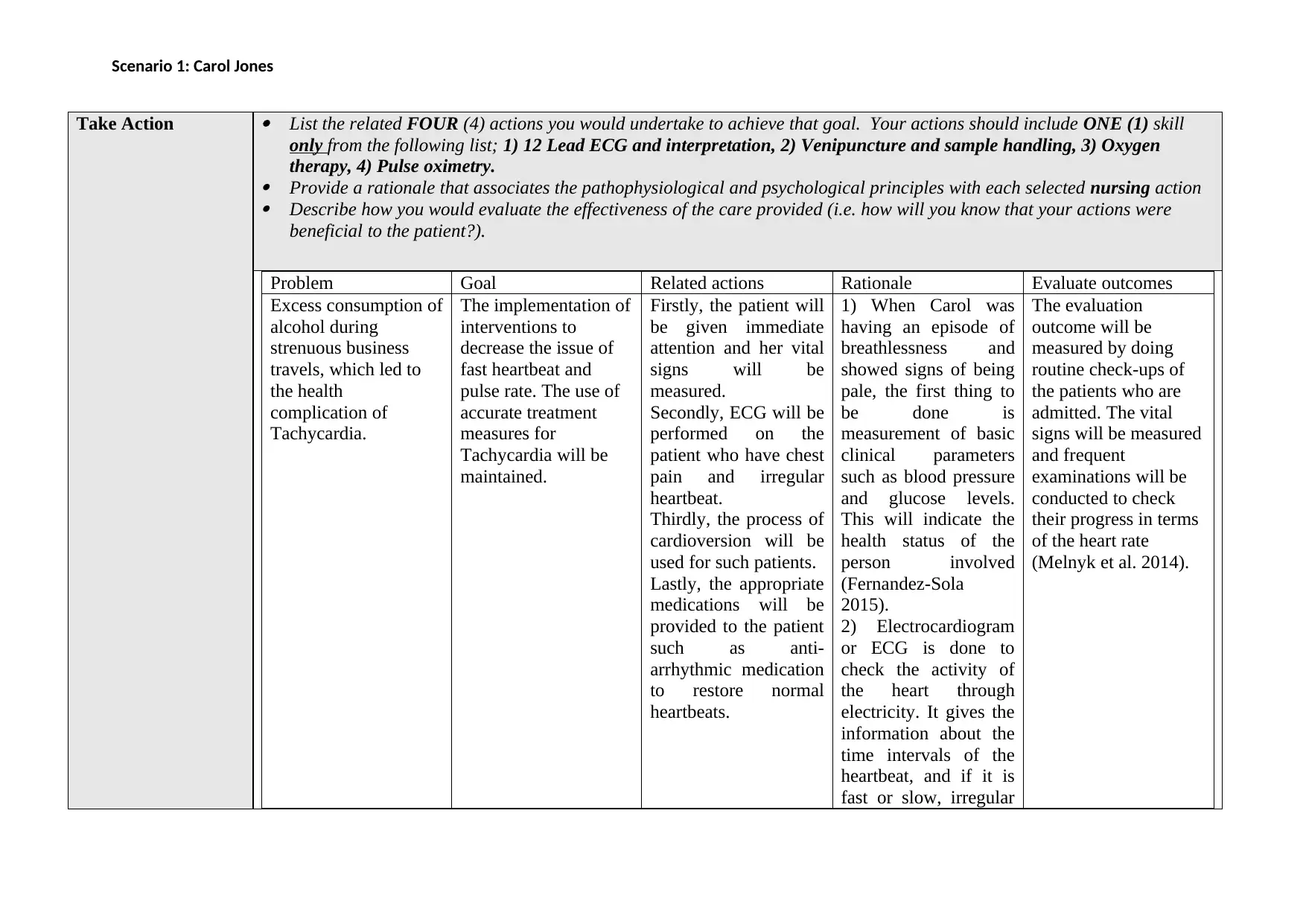
Scenario 1: Carol Jones
Take Action
List the related FOUR (4) actions you would undertake to achieve that goal. Your actions should include ONE (1) skill
only from the following list; 1) 12 Lead ECG and interpretation, 2) Venipuncture and sample handling, 3) Oxygen
therapy, 4) Pulse oximetry.
Provide a rationale that associates the pathophysiological and psychological principles with each selected nursing action
Describe how you would evaluate the effectiveness of the care provided (i.e. how will you know that your actions were
beneficial to the patient?).
Problem Goal Related actions Rationale Evaluate outcomes
Excess consumption of
alcohol during
strenuous business
travels, which led to
the health
complication of
Tachycardia.
The implementation of
interventions to
decrease the issue of
fast heartbeat and
pulse rate. The use of
accurate treatment
measures for
Tachycardia will be
maintained.
Firstly, the patient will
be given immediate
attention and her vital
signs will be
measured.
Secondly, ECG will be
performed on the
patient who have chest
pain and irregular
heartbeat.
Thirdly, the process of
cardioversion will be
used for such patients.
Lastly, the appropriate
medications will be
provided to the patient
such as anti-
arrhythmic medication
to restore normal
heartbeats.
1) When Carol was
having an episode of
breathlessness and
showed signs of being
pale, the first thing to
be done is
measurement of basic
clinical parameters
such as blood pressure
and glucose levels.
This will indicate the
health status of the
person involved
(Fernandez-Sola
2015).
2) Electrocardiogram
or ECG is done to
check the activity of
the heart through
electricity. It gives the
information about the
time intervals of the
heartbeat, and if it is
fast or slow, irregular
The evaluation
outcome will be
measured by doing
routine check-ups of
the patients who are
admitted. The vital
signs will be measured
and frequent
examinations will be
conducted to check
their progress in terms
of the heart rate
(Melnyk et al. 2014).
Take Action
List the related FOUR (4) actions you would undertake to achieve that goal. Your actions should include ONE (1) skill
only from the following list; 1) 12 Lead ECG and interpretation, 2) Venipuncture and sample handling, 3) Oxygen
therapy, 4) Pulse oximetry.
Provide a rationale that associates the pathophysiological and psychological principles with each selected nursing action
Describe how you would evaluate the effectiveness of the care provided (i.e. how will you know that your actions were
beneficial to the patient?).
Problem Goal Related actions Rationale Evaluate outcomes
Excess consumption of
alcohol during
strenuous business
travels, which led to
the health
complication of
Tachycardia.
The implementation of
interventions to
decrease the issue of
fast heartbeat and
pulse rate. The use of
accurate treatment
measures for
Tachycardia will be
maintained.
Firstly, the patient will
be given immediate
attention and her vital
signs will be
measured.
Secondly, ECG will be
performed on the
patient who have chest
pain and irregular
heartbeat.
Thirdly, the process of
cardioversion will be
used for such patients.
Lastly, the appropriate
medications will be
provided to the patient
such as anti-
arrhythmic medication
to restore normal
heartbeats.
1) When Carol was
having an episode of
breathlessness and
showed signs of being
pale, the first thing to
be done is
measurement of basic
clinical parameters
such as blood pressure
and glucose levels.
This will indicate the
health status of the
person involved
(Fernandez-Sola
2015).
2) Electrocardiogram
or ECG is done to
check the activity of
the heart through
electricity. It gives the
information about the
time intervals of the
heartbeat, and if it is
fast or slow, irregular
The evaluation
outcome will be
measured by doing
routine check-ups of
the patients who are
admitted. The vital
signs will be measured
and frequent
examinations will be
conducted to check
their progress in terms
of the heart rate
(Melnyk et al. 2014).
Paraphrase This Document
Need a fresh take? Get an instant paraphrase of this document with our AI Paraphraser
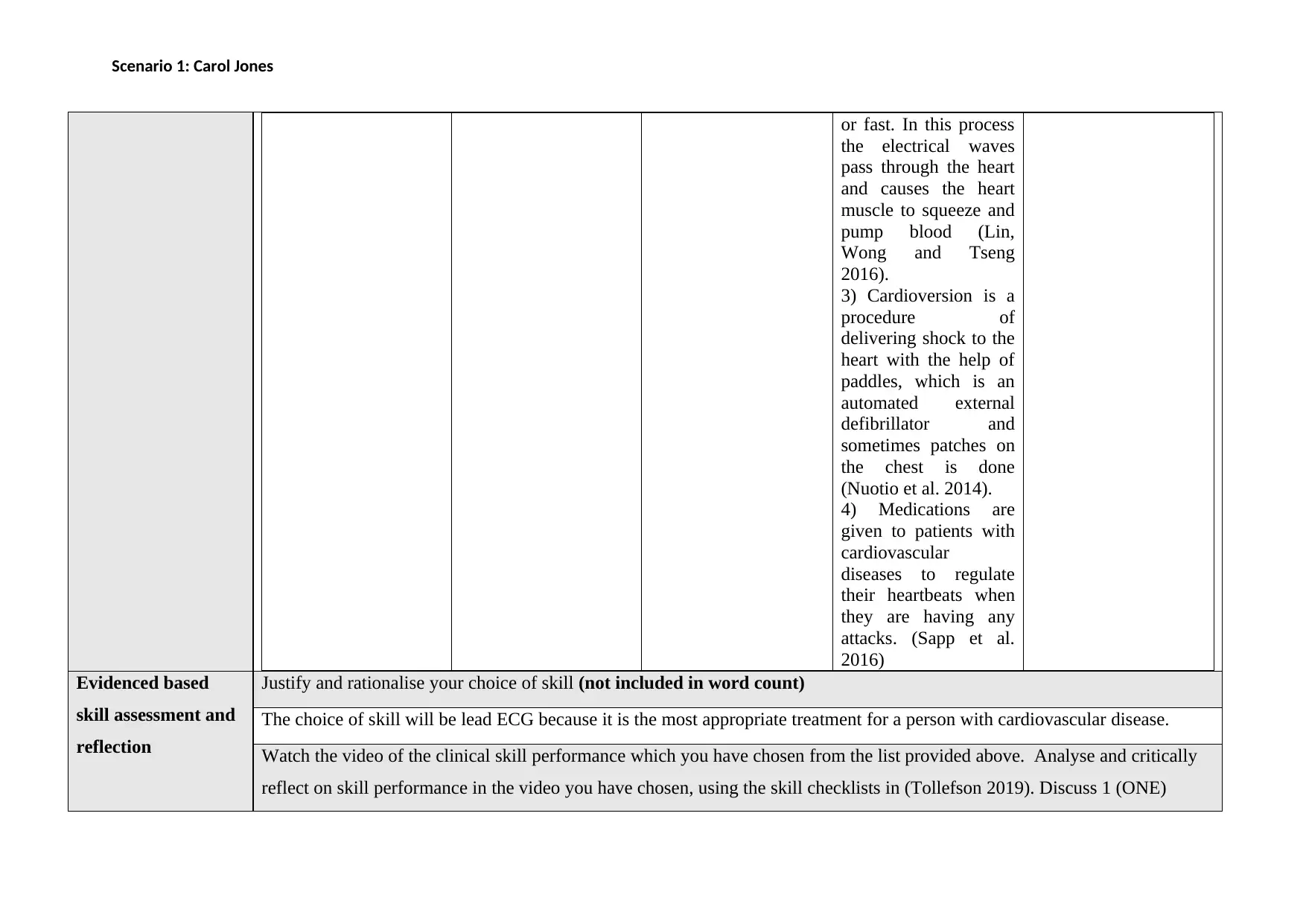
Scenario 1: Carol Jones
or fast. In this process
the electrical waves
pass through the heart
and causes the heart
muscle to squeeze and
pump blood (Lin,
Wong and Tseng
2016).
3) Cardioversion is a
procedure of
delivering shock to the
heart with the help of
paddles, which is an
automated external
defibrillator and
sometimes patches on
the chest is done
(Nuotio et al. 2014).
4) Medications are
given to patients with
cardiovascular
diseases to regulate
their heartbeats when
they are having any
attacks. (Sapp et al.
2016)
Evidenced based
skill assessment and
reflection
Justify and rationalise your choice of skill (not included in word count)
The choice of skill will be lead ECG because it is the most appropriate treatment for a person with cardiovascular disease.
Watch the video of the clinical skill performance which you have chosen from the list provided above. Analyse and critically
reflect on skill performance in the video you have chosen, using the skill checklists in (Tollefson 2019). Discuss 1 (ONE)
or fast. In this process
the electrical waves
pass through the heart
and causes the heart
muscle to squeeze and
pump blood (Lin,
Wong and Tseng
2016).
3) Cardioversion is a
procedure of
delivering shock to the
heart with the help of
paddles, which is an
automated external
defibrillator and
sometimes patches on
the chest is done
(Nuotio et al. 2014).
4) Medications are
given to patients with
cardiovascular
diseases to regulate
their heartbeats when
they are having any
attacks. (Sapp et al.
2016)
Evidenced based
skill assessment and
reflection
Justify and rationalise your choice of skill (not included in word count)
The choice of skill will be lead ECG because it is the most appropriate treatment for a person with cardiovascular disease.
Watch the video of the clinical skill performance which you have chosen from the list provided above. Analyse and critically
reflect on skill performance in the video you have chosen, using the skill checklists in (Tollefson 2019). Discuss 1 (ONE)
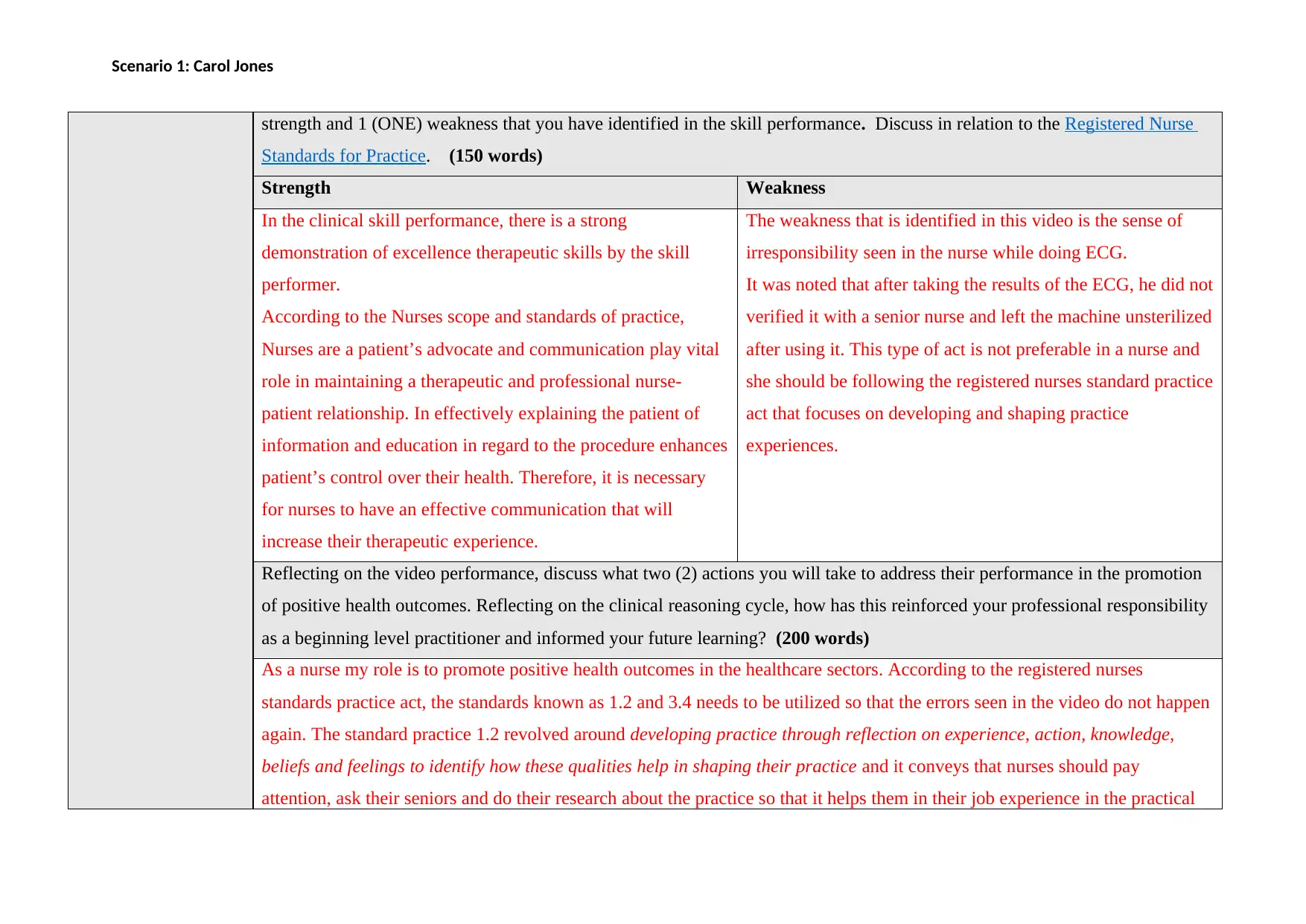
Scenario 1: Carol Jones
strength and 1 (ONE) weakness that you have identified in the skill performance. Discuss in relation to the Registered Nurse
Standards for Practice. (150 words)
Strength Weakness
In the clinical skill performance, there is a strong
demonstration of excellence therapeutic skills by the skill
performer.
According to the Nurses scope and standards of practice,
Nurses are a patient’s advocate and communication play vital
role in maintaining a therapeutic and professional nurse-
patient relationship. In effectively explaining the patient of
information and education in regard to the procedure enhances
patient’s control over their health. Therefore, it is necessary
for nurses to have an effective communication that will
increase their therapeutic experience.
The weakness that is identified in this video is the sense of
irresponsibility seen in the nurse while doing ECG.
It was noted that after taking the results of the ECG, he did not
verified it with a senior nurse and left the machine unsterilized
after using it. This type of act is not preferable in a nurse and
she should be following the registered nurses standard practice
act that focuses on developing and shaping practice
experiences.
Reflecting on the video performance, discuss what two (2) actions you will take to address their performance in the promotion
of positive health outcomes. Reflecting on the clinical reasoning cycle, how has this reinforced your professional responsibility
as a beginning level practitioner and informed your future learning? (200 words)
As a nurse my role is to promote positive health outcomes in the healthcare sectors. According to the registered nurses
standards practice act, the standards known as 1.2 and 3.4 needs to be utilized so that the errors seen in the video do not happen
again. The standard practice 1.2 revolved around developing practice through reflection on experience, action, knowledge,
beliefs and feelings to identify how these qualities help in shaping their practice and it conveys that nurses should pay
attention, ask their seniors and do their research about the practice so that it helps them in their job experience in the practical
strength and 1 (ONE) weakness that you have identified in the skill performance. Discuss in relation to the Registered Nurse
Standards for Practice. (150 words)
Strength Weakness
In the clinical skill performance, there is a strong
demonstration of excellence therapeutic skills by the skill
performer.
According to the Nurses scope and standards of practice,
Nurses are a patient’s advocate and communication play vital
role in maintaining a therapeutic and professional nurse-
patient relationship. In effectively explaining the patient of
information and education in regard to the procedure enhances
patient’s control over their health. Therefore, it is necessary
for nurses to have an effective communication that will
increase their therapeutic experience.
The weakness that is identified in this video is the sense of
irresponsibility seen in the nurse while doing ECG.
It was noted that after taking the results of the ECG, he did not
verified it with a senior nurse and left the machine unsterilized
after using it. This type of act is not preferable in a nurse and
she should be following the registered nurses standard practice
act that focuses on developing and shaping practice
experiences.
Reflecting on the video performance, discuss what two (2) actions you will take to address their performance in the promotion
of positive health outcomes. Reflecting on the clinical reasoning cycle, how has this reinforced your professional responsibility
as a beginning level practitioner and informed your future learning? (200 words)
As a nurse my role is to promote positive health outcomes in the healthcare sectors. According to the registered nurses
standards practice act, the standards known as 1.2 and 3.4 needs to be utilized so that the errors seen in the video do not happen
again. The standard practice 1.2 revolved around developing practice through reflection on experience, action, knowledge,
beliefs and feelings to identify how these qualities help in shaping their practice and it conveys that nurses should pay
attention, ask their seniors and do their research about the practice so that it helps them in their job experience in the practical
⊘ This is a preview!⊘
Do you want full access?
Subscribe today to unlock all pages.

Trusted by 1+ million students worldwide
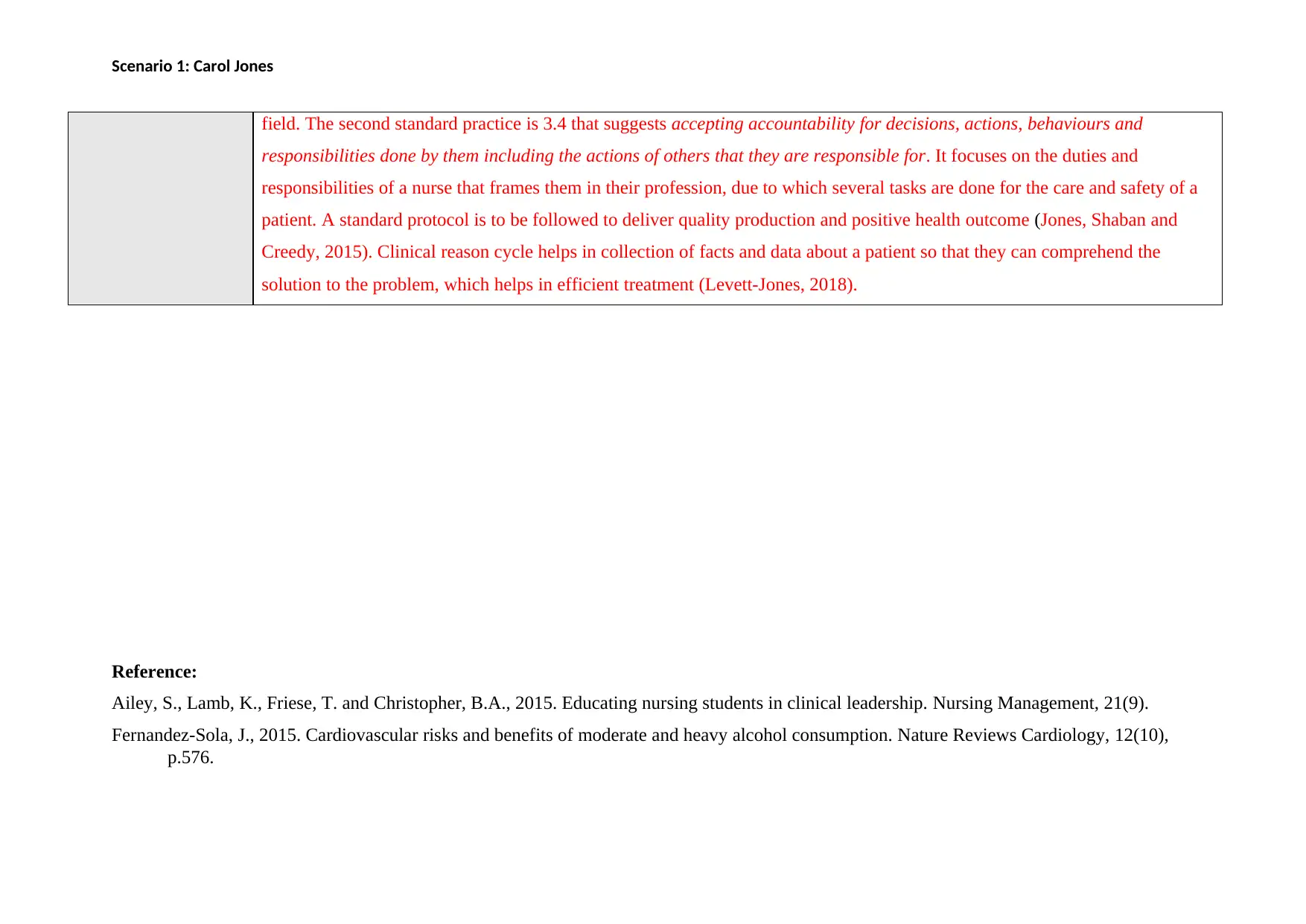
Scenario 1: Carol Jones
field. The second standard practice is 3.4 that suggests accepting accountability for decisions, actions, behaviours and
responsibilities done by them including the actions of others that they are responsible for. It focuses on the duties and
responsibilities of a nurse that frames them in their profession, due to which several tasks are done for the care and safety of a
patient. A standard protocol is to be followed to deliver quality production and positive health outcome (Jones, Shaban and
Creedy, 2015). Clinical reason cycle helps in collection of facts and data about a patient so that they can comprehend the
solution to the problem, which helps in efficient treatment (Levett-Jones, 2018).
Reference:
Ailey, S., Lamb, K., Friese, T. and Christopher, B.A., 2015. Educating nursing students in clinical leadership. Nursing Management, 21(9).
Fernandez-Sola, J., 2015. Cardiovascular risks and benefits of moderate and heavy alcohol consumption. Nature Reviews Cardiology, 12(10),
p.576.
field. The second standard practice is 3.4 that suggests accepting accountability for decisions, actions, behaviours and
responsibilities done by them including the actions of others that they are responsible for. It focuses on the duties and
responsibilities of a nurse that frames them in their profession, due to which several tasks are done for the care and safety of a
patient. A standard protocol is to be followed to deliver quality production and positive health outcome (Jones, Shaban and
Creedy, 2015). Clinical reason cycle helps in collection of facts and data about a patient so that they can comprehend the
solution to the problem, which helps in efficient treatment (Levett-Jones, 2018).
Reference:
Ailey, S., Lamb, K., Friese, T. and Christopher, B.A., 2015. Educating nursing students in clinical leadership. Nursing Management, 21(9).
Fernandez-Sola, J., 2015. Cardiovascular risks and benefits of moderate and heavy alcohol consumption. Nature Reviews Cardiology, 12(10),
p.576.
Paraphrase This Document
Need a fresh take? Get an instant paraphrase of this document with our AI Paraphraser
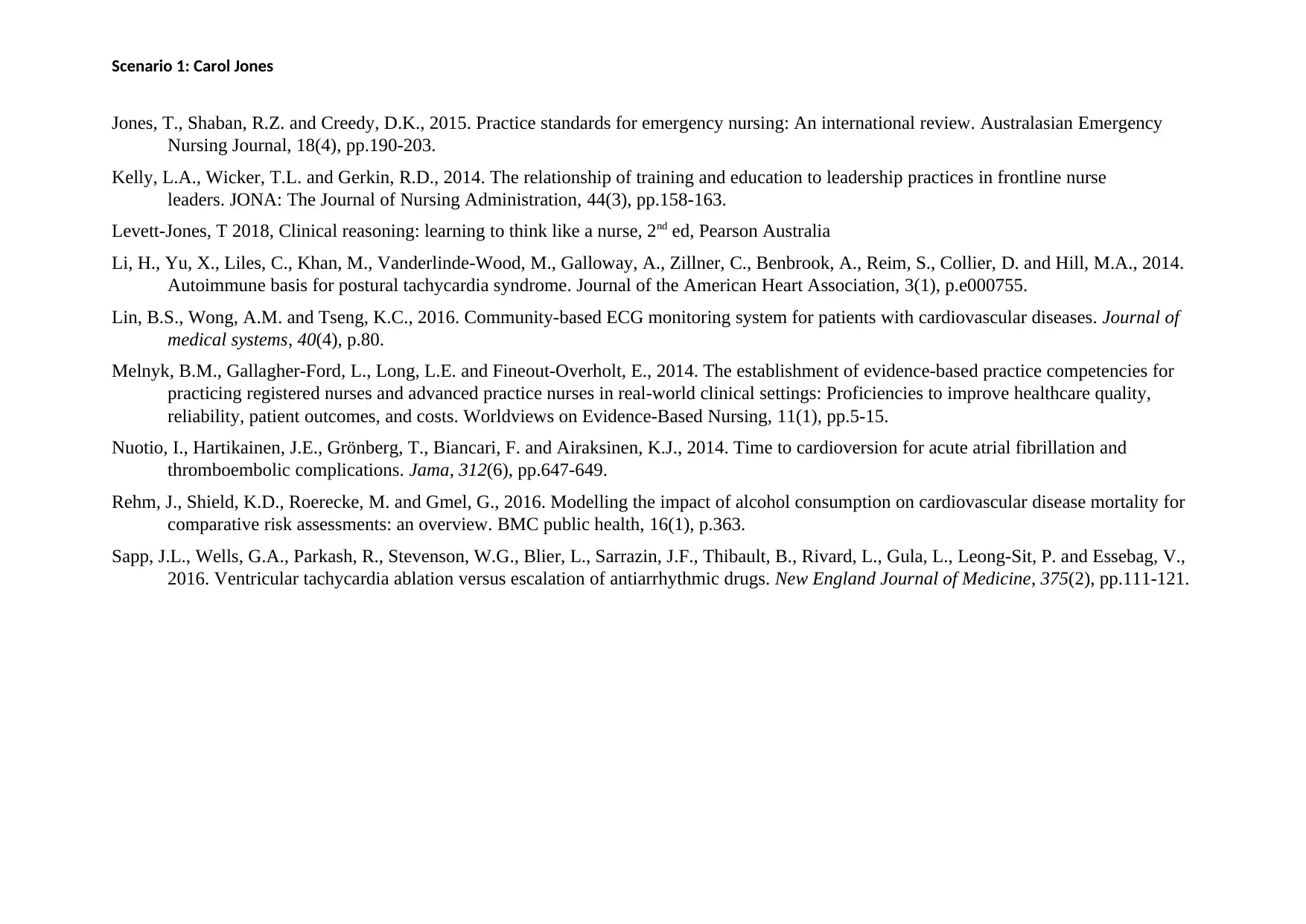
Scenario 1: Carol Jones
Jones, T., Shaban, R.Z. and Creedy, D.K., 2015. Practice standards for emergency nursing: An international review. Australasian Emergency
Nursing Journal, 18(4), pp.190-203.
Kelly, L.A., Wicker, T.L. and Gerkin, R.D., 2014. The relationship of training and education to leadership practices in frontline nurse
leaders. JONA: The Journal of Nursing Administration, 44(3), pp.158-163.
Levett-Jones, T 2018, Clinical reasoning: learning to think like a nurse, 2nd ed, Pearson Australia
Li, H., Yu, X., Liles, C., Khan, M., Vanderlinde‐Wood, M., Galloway, A., Zillner, C., Benbrook, A., Reim, S., Collier, D. and Hill, M.A., 2014.
Autoimmune basis for postural tachycardia syndrome. Journal of the American Heart Association, 3(1), p.e000755.
Lin, B.S., Wong, A.M. and Tseng, K.C., 2016. Community-based ECG monitoring system for patients with cardiovascular diseases. Journal of
medical systems, 40(4), p.80.
Melnyk, B.M., Gallagher‐Ford, L., Long, L.E. and Fineout‐Overholt, E., 2014. The establishment of evidence‐based practice competencies for
practicing registered nurses and advanced practice nurses in real‐world clinical settings: Proficiencies to improve healthcare quality,
reliability, patient outcomes, and costs. Worldviews on Evidence‐Based Nursing, 11(1), pp.5-15.
Nuotio, I., Hartikainen, J.E., Grönberg, T., Biancari, F. and Airaksinen, K.J., 2014. Time to cardioversion for acute atrial fibrillation and
thromboembolic complications. Jama, 312(6), pp.647-649.
Rehm, J., Shield, K.D., Roerecke, M. and Gmel, G., 2016. Modelling the impact of alcohol consumption on cardiovascular disease mortality for
comparative risk assessments: an overview. BMC public health, 16(1), p.363.
Sapp, J.L., Wells, G.A., Parkash, R., Stevenson, W.G., Blier, L., Sarrazin, J.F., Thibault, B., Rivard, L., Gula, L., Leong-Sit, P. and Essebag, V.,
2016. Ventricular tachycardia ablation versus escalation of antiarrhythmic drugs. New England Journal of Medicine, 375(2), pp.111-121.
Jones, T., Shaban, R.Z. and Creedy, D.K., 2015. Practice standards for emergency nursing: An international review. Australasian Emergency
Nursing Journal, 18(4), pp.190-203.
Kelly, L.A., Wicker, T.L. and Gerkin, R.D., 2014. The relationship of training and education to leadership practices in frontline nurse
leaders. JONA: The Journal of Nursing Administration, 44(3), pp.158-163.
Levett-Jones, T 2018, Clinical reasoning: learning to think like a nurse, 2nd ed, Pearson Australia
Li, H., Yu, X., Liles, C., Khan, M., Vanderlinde‐Wood, M., Galloway, A., Zillner, C., Benbrook, A., Reim, S., Collier, D. and Hill, M.A., 2014.
Autoimmune basis for postural tachycardia syndrome. Journal of the American Heart Association, 3(1), p.e000755.
Lin, B.S., Wong, A.M. and Tseng, K.C., 2016. Community-based ECG monitoring system for patients with cardiovascular diseases. Journal of
medical systems, 40(4), p.80.
Melnyk, B.M., Gallagher‐Ford, L., Long, L.E. and Fineout‐Overholt, E., 2014. The establishment of evidence‐based practice competencies for
practicing registered nurses and advanced practice nurses in real‐world clinical settings: Proficiencies to improve healthcare quality,
reliability, patient outcomes, and costs. Worldviews on Evidence‐Based Nursing, 11(1), pp.5-15.
Nuotio, I., Hartikainen, J.E., Grönberg, T., Biancari, F. and Airaksinen, K.J., 2014. Time to cardioversion for acute atrial fibrillation and
thromboembolic complications. Jama, 312(6), pp.647-649.
Rehm, J., Shield, K.D., Roerecke, M. and Gmel, G., 2016. Modelling the impact of alcohol consumption on cardiovascular disease mortality for
comparative risk assessments: an overview. BMC public health, 16(1), p.363.
Sapp, J.L., Wells, G.A., Parkash, R., Stevenson, W.G., Blier, L., Sarrazin, J.F., Thibault, B., Rivard, L., Gula, L., Leong-Sit, P. and Essebag, V.,
2016. Ventricular tachycardia ablation versus escalation of antiarrhythmic drugs. New England Journal of Medicine, 375(2), pp.111-121.
1 out of 8
Related Documents
Your All-in-One AI-Powered Toolkit for Academic Success.
+13062052269
info@desklib.com
Available 24*7 on WhatsApp / Email
![[object Object]](/_next/static/media/star-bottom.7253800d.svg)
Unlock your academic potential
Copyright © 2020–2025 A2Z Services. All Rights Reserved. Developed and managed by ZUCOL.




